Short-Term Wind Power Forecasting Using the Enhanced Particle Swarm Optimization Based Hybrid Method
Abstract
:1. Introduction
2. Individual Forecasting Methods Used in the Hybrid Method
2.1. Persistence Method
2.2. Back Propagation Neural Network Method
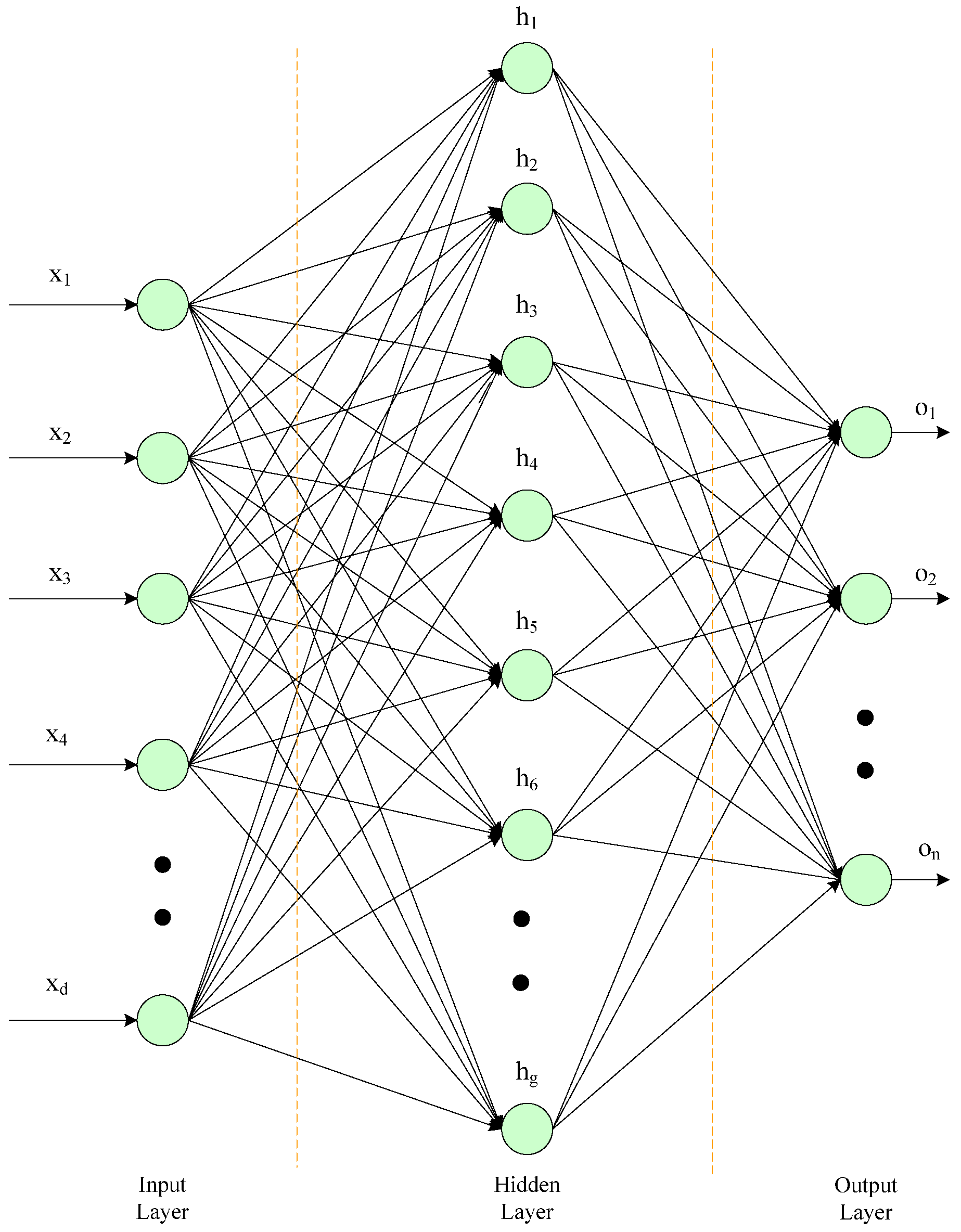
- Step 1
- Create the database of the wind power generation of WECS;
- Step 2
- Normalize all of the wind power generation data;
- Step 3
- Prepare the training set for the back propagation neural network;
- Step 4
- Use the error back propagation algorithm to train the back propagation neural network for wind power forecasting;
- Step 5
- Save the weights between the layers and bias of the neurons of the trained back propagation neural network, as the training procedure is finished;
- Step 6
- Use the trained back propagation neural network to forecast the wind power generation of WECS.
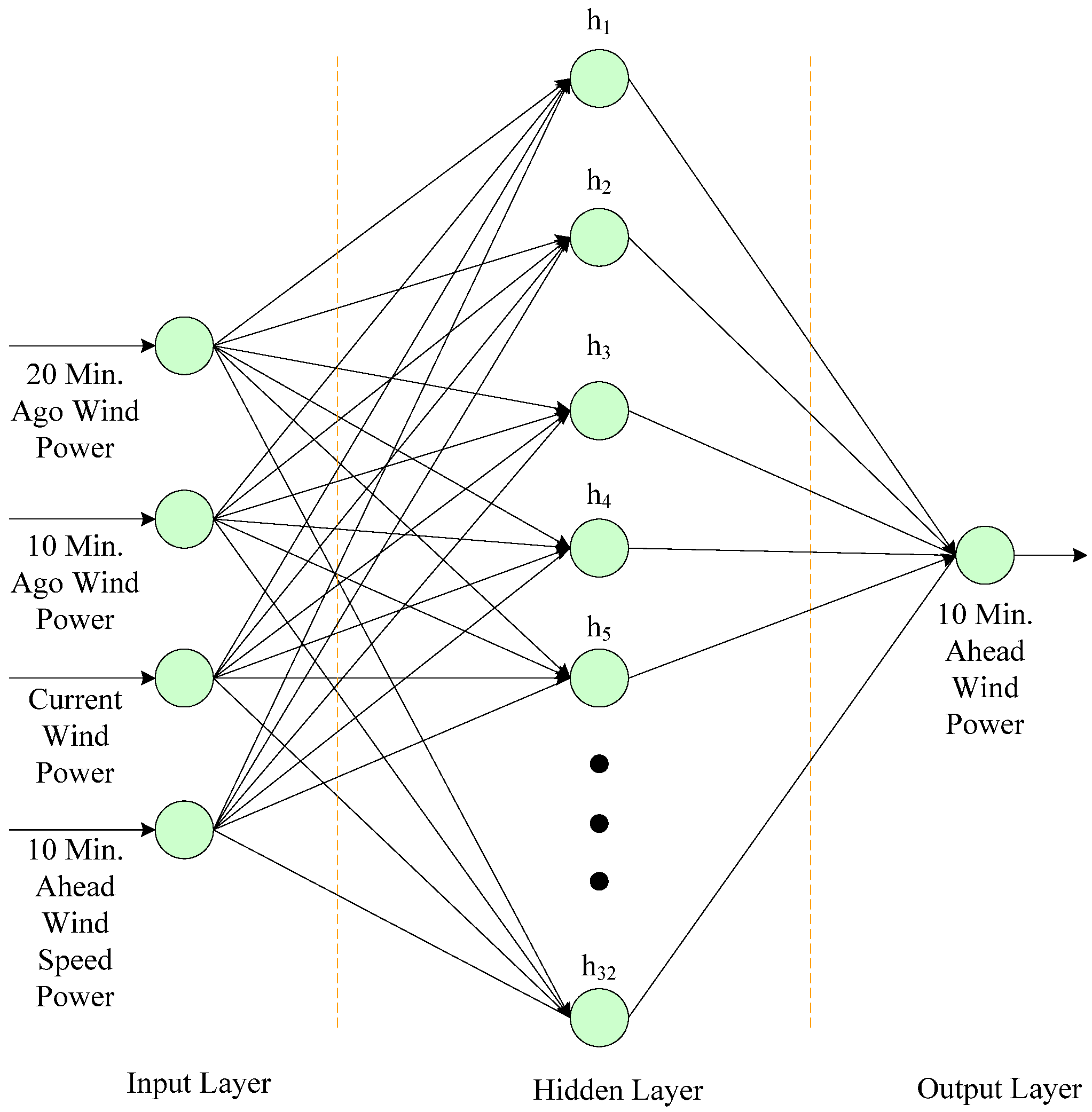
2.3. RBF Neural Network Method
- Step 1
- Create a database of wind power generation of WECS;
- Step 2
- Normalize all the wind power generation data;
- Step 3
- Prepare the training set for the RBF neural network;
- Step 4
- Using the training set to train the RBF neural network for wind power forecasting;
- Step 5
- Save the Gaussian functions centers, widths and connection weights between the hidden and output layers of the trained RBF neural network, as the training procedure is finished;
- Step 6
- Use the trained RBF neural network to forecast the wind power generation of the WECS.
3. The Combination Theory of the Proposed Hybrid Method
4. Determining Weight Coefficients of Hybrid Method by EPSO Algorithm
4.1. Principle of EPSO Algorithm
4.2. Determination of Weight Coefficients by EPSO Algorithm
- Step 1
- Randomly generate N particles pid (i = 1, 2,…., N and d = 1, 2,…., D), subject to pid ∈ (0, 1) and , vid ∈ [vmin, vmax], tmax is the maximum iteration number;
- Step 2
- Calculate the adaptive degree by , i = 1, 2,..., N, where yt is the actual value; and is the combined forecasting value of the hybrid method calculated by Equation (12).
- Step 3
- On the basis of the adaptive degree, the so-far best position pbest for each particle, the so-far best position for the entire swarm gbest are calculated and the new particles will be generated using Equations (14–18) mentioned above and Equation (19), Equation (19) is expressed as follows:where d = 1, 2,…., D − 1, i = 1, 2,…., N, t = 1, 2,…., tmax, and satisfies the following restrictions:
- Step 4
- Check whether the termination criteria are satisfied. The termination criteria are either achieving the forecasting precision or reaching the maximum iteration number. If the termination criterions are not satisfied, go back to Step 2, otherwise, go to Step 5;
- Step 5
- The termination criteria are satisfied. Terminate the EPSO process and output the results.
5. Numerical Results



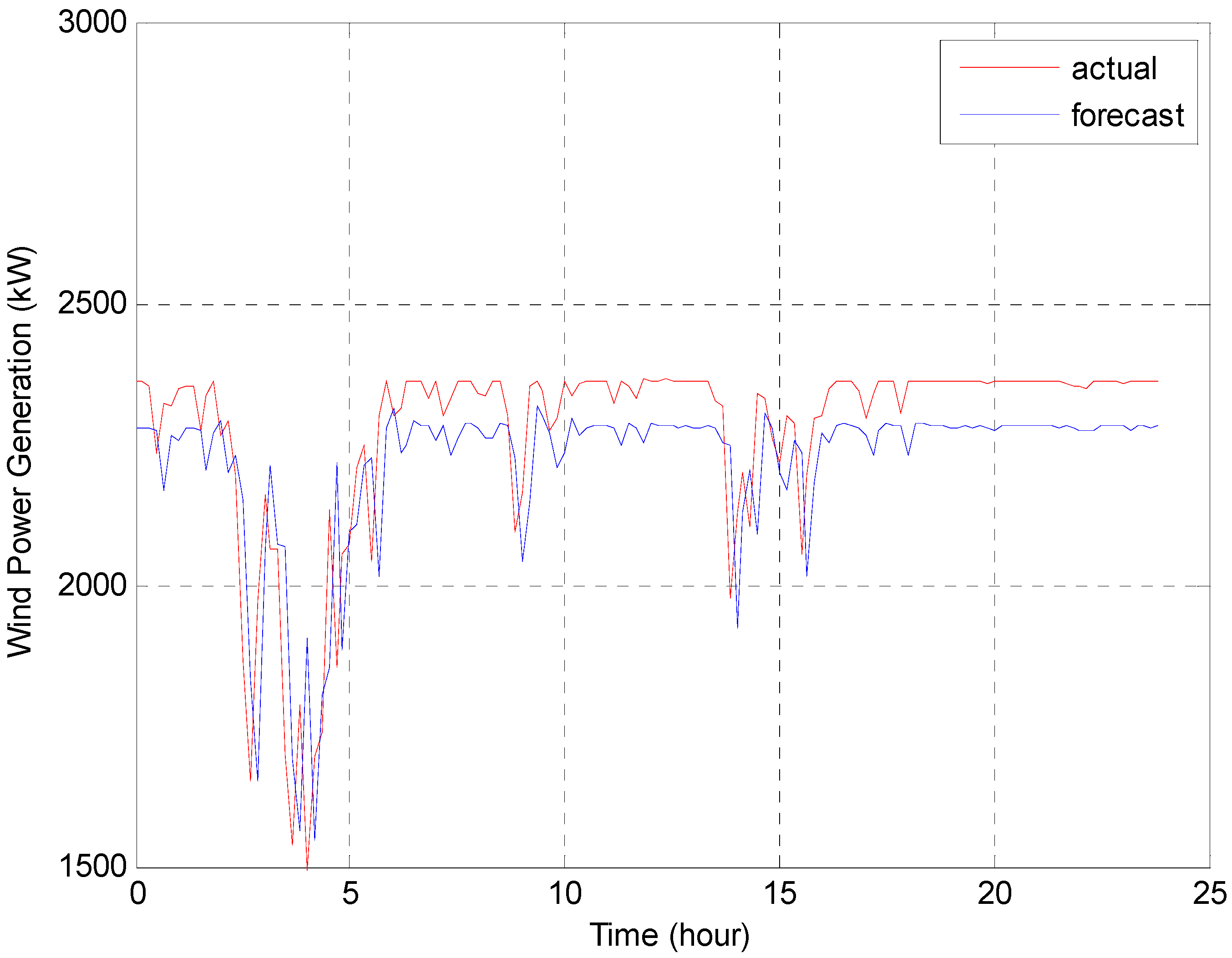
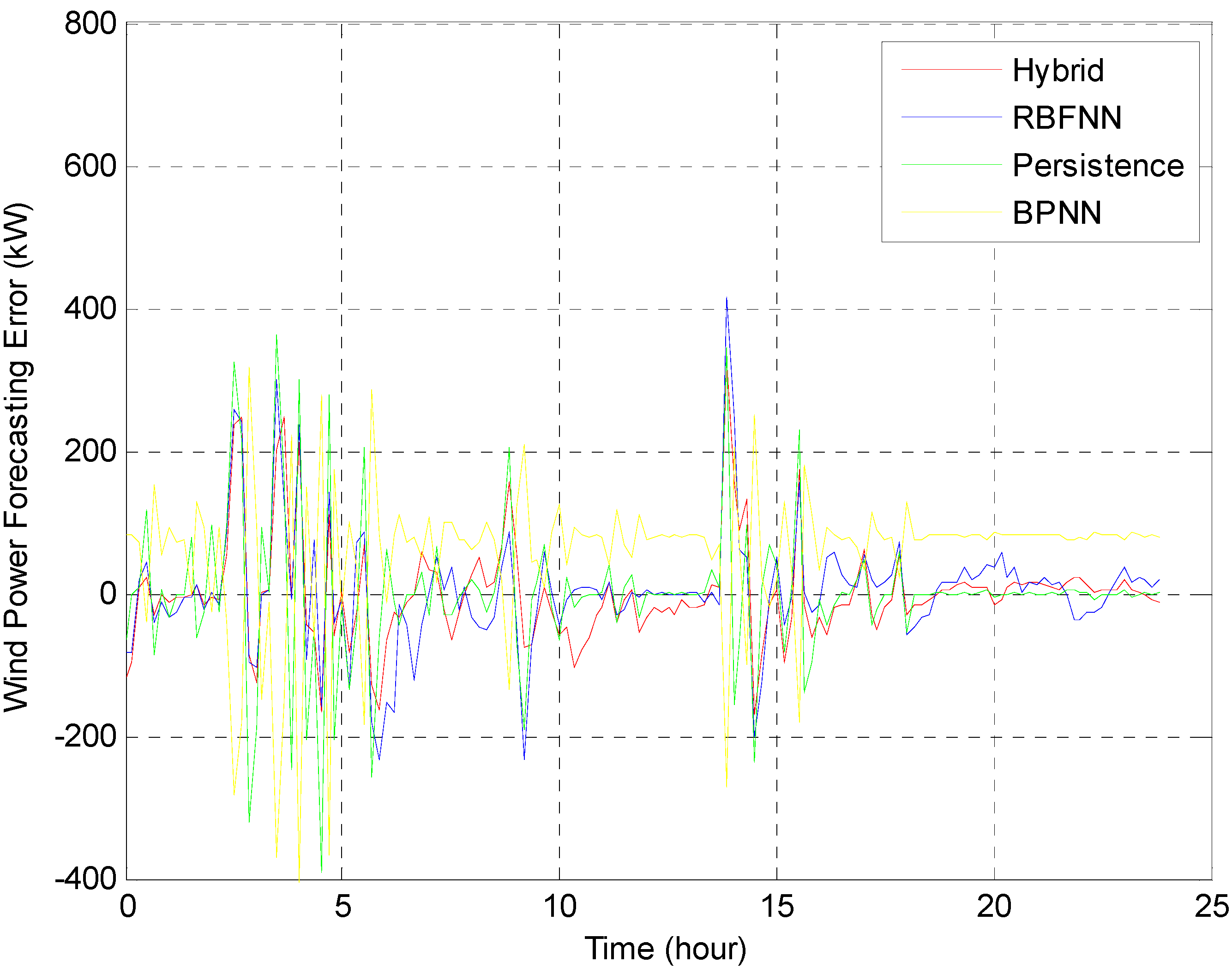
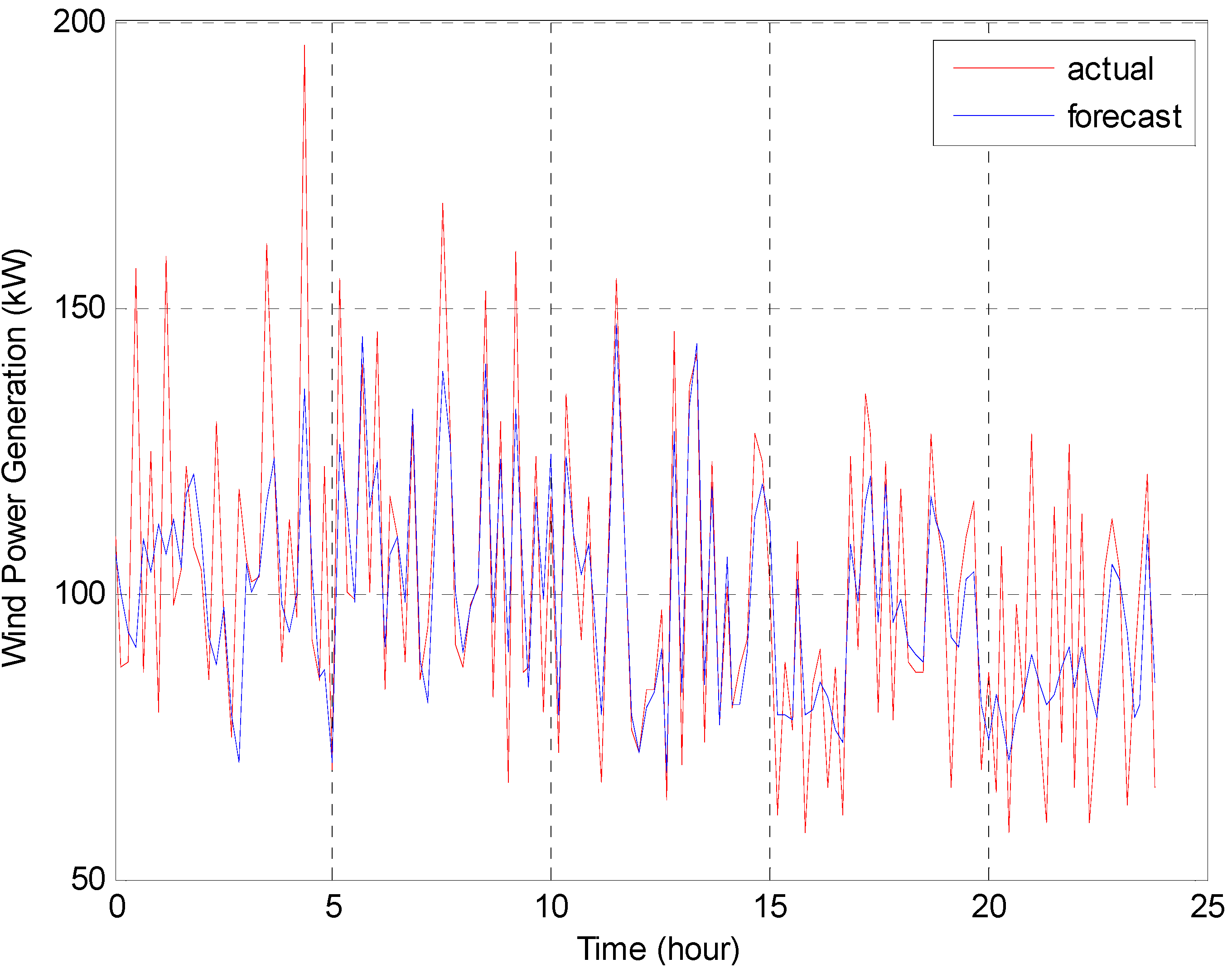
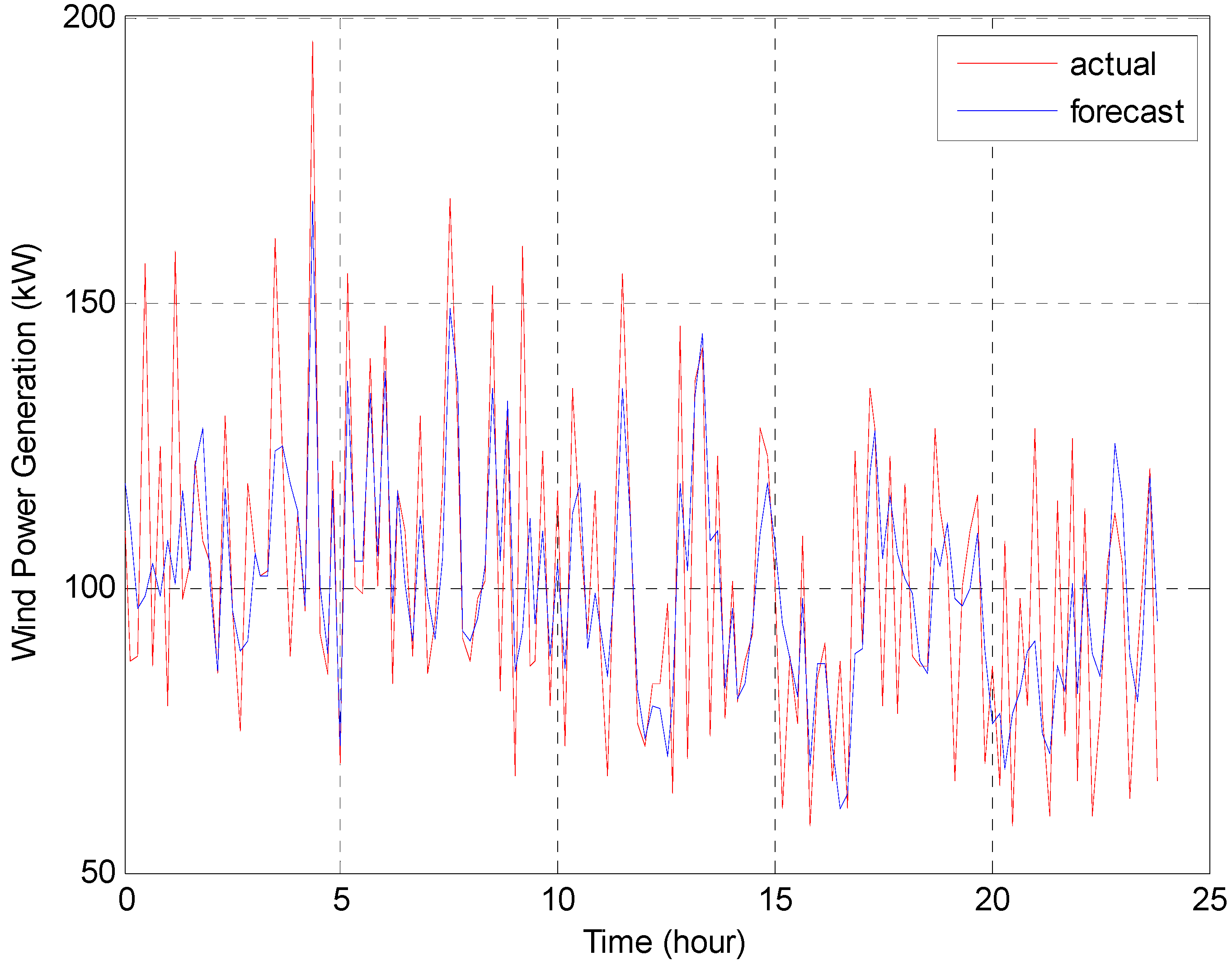
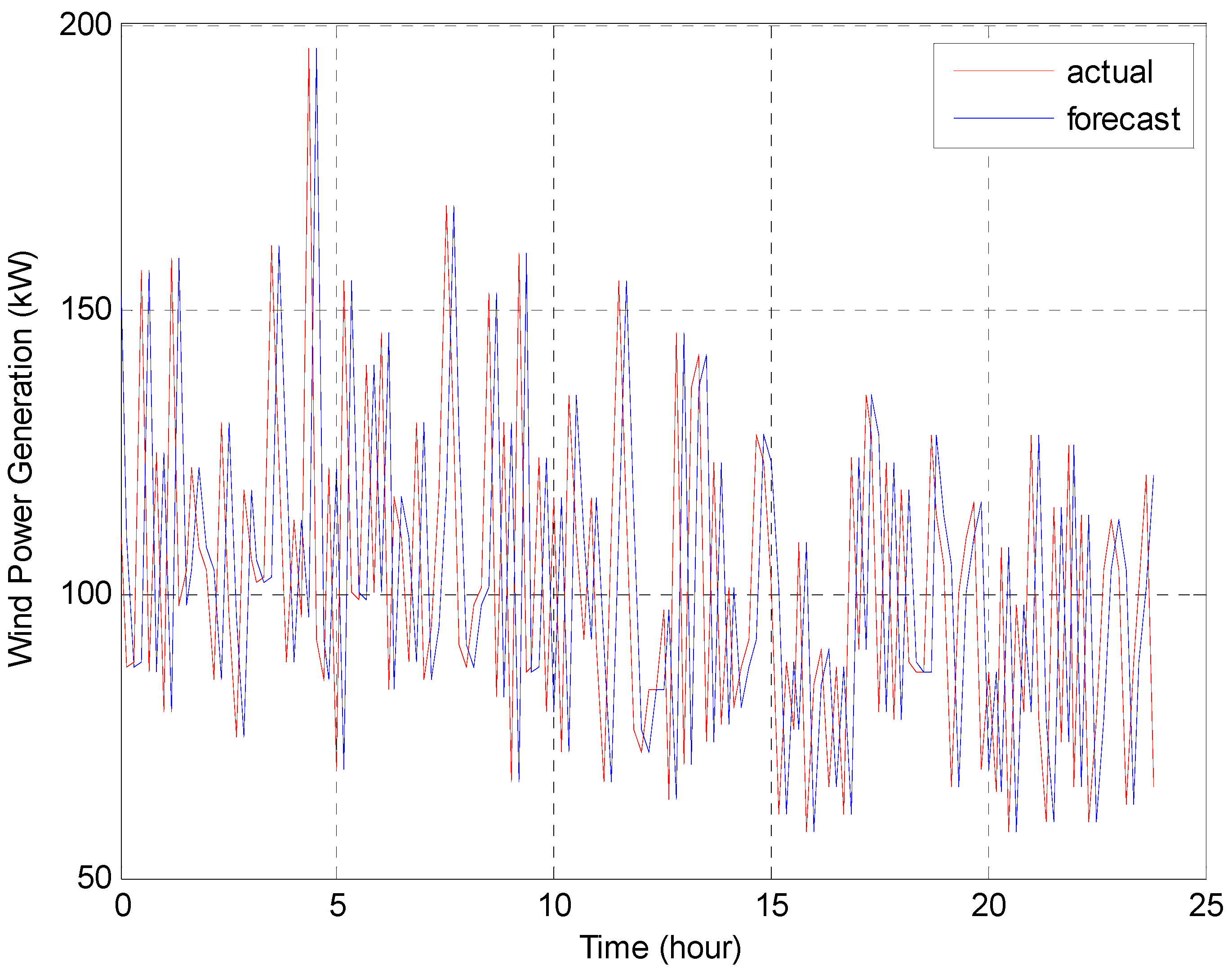
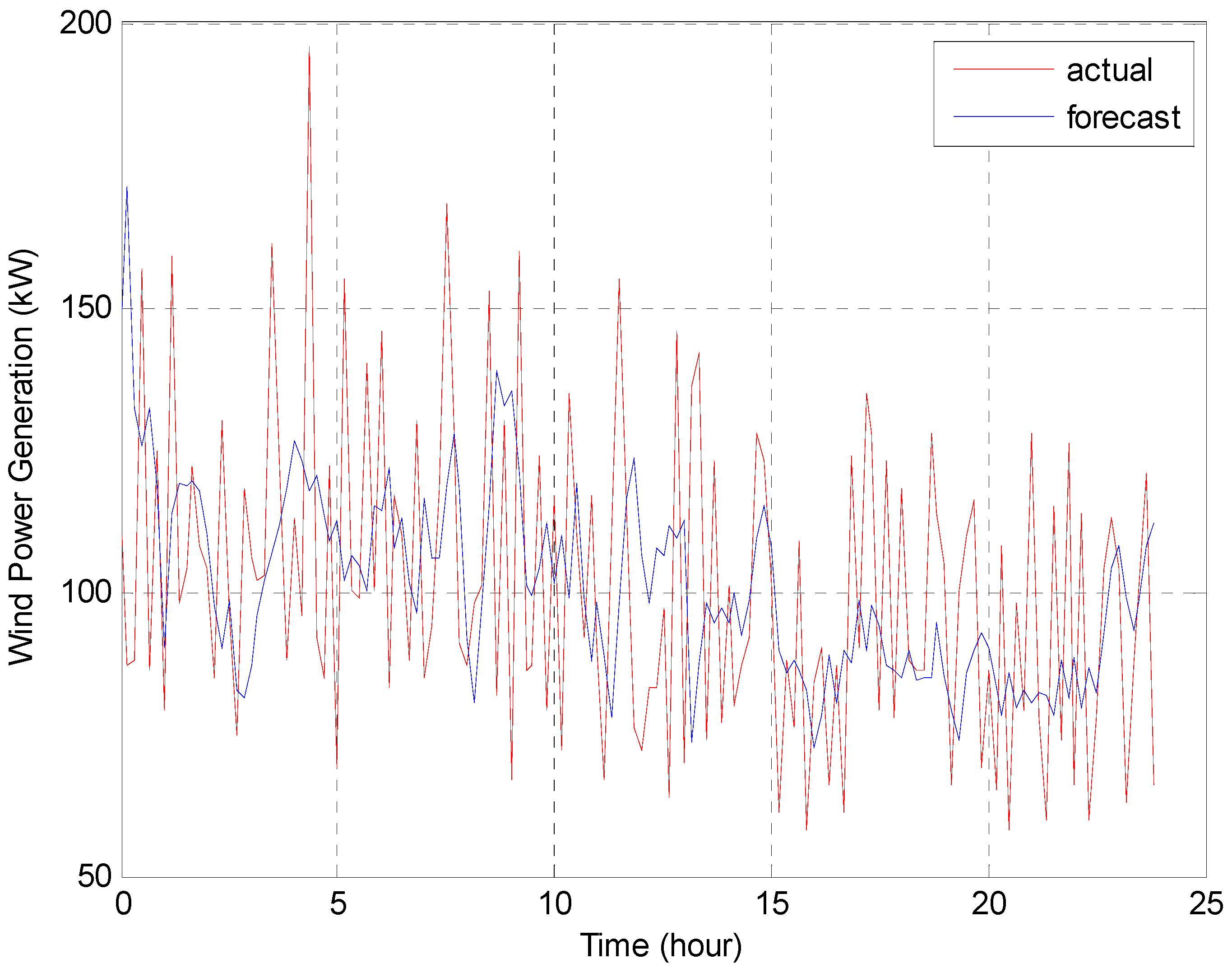
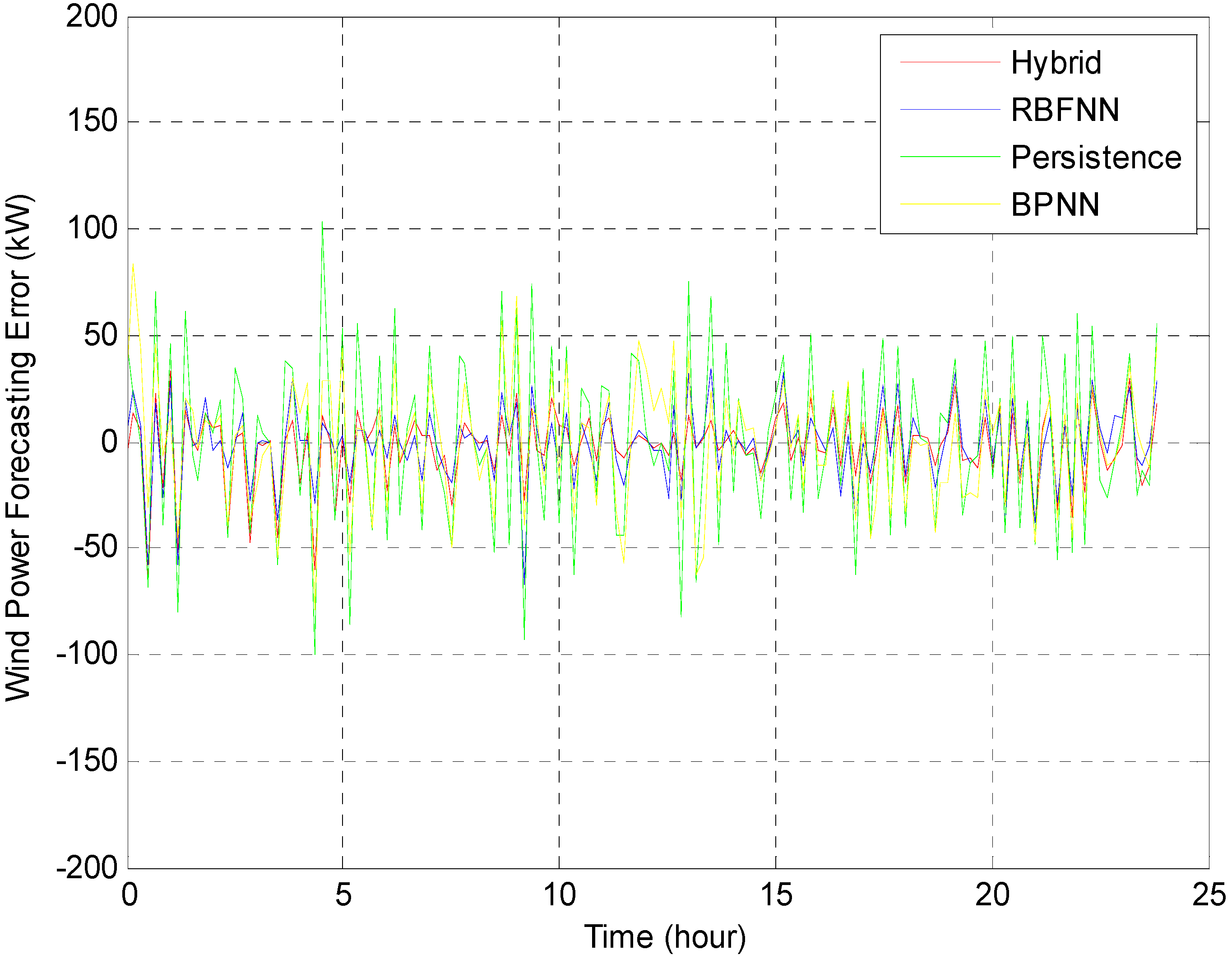
| Season | Forecasting method | Maximum absolute percentage error | Mean absolute percentage error |
|---|---|---|---|
| Spring day | Proposed hybrid method | 64.65% | 6.57% |
| RBF neural network-based method | 68.42% | 7.05% | |
| Persistence method | 116.44% | 8.49% | |
| Back propagation neural network method | 69.91% | 7.58% | |
| Summer day | Proposed hybrid method | 47.61% | 12.38% |
| RBF neural network-based method | 53.67% | 13.42% | |
| Persistence method | 113.04% | 35.42% | |
| Back propagation neural network method | 102.25% | 23.95% | |
| Autumn day | Proposed hybrid method | 117.44% | 24.96% |
| RBF neural network-based method | 117.55% | 28.98% | |
| Persistence method | 186.67% | 39.57% | |
| Back propagation neural network method | 128.82% | 34.37% | |
| Winter day | Proposed hybrid method | 16.65% | 2.17% |
| RBF neural network-based method | 21.01% | 2.41% | |
| Persistence method | 21.44% | 2.76% | |
| Back propagation neural network method | 28.17% | 4.53% |
6. Conclusions
Acknowledgements
Conflicts of Interest
References
- Chang, W.Y. An RBF neural network combined with OLS algorithm and genetic algorithm for short-term wind power forecasting. J. Appl. Math. 2013, 2013. [Google Scholar] [CrossRef]
- 2012 Half Year Report; The World Wind Energy Association: Bonn, Germany, 2012.
- Wu, Z.; Zhu, C.; Hu, M. Improved control strategy for DFIG wind turbines for low voltage ride through. Energies 2013, 6, 1181–1197. [Google Scholar] [CrossRef]
- Kabouris, J.; Kanellos, F.D. Impacts of large scale wind penetration on energy supply industry. Energies 2009, 2, 1031–1041. [Google Scholar] [CrossRef]
- Sideratos, G.; Hatziargyriou, N.D. An advanced statistical method for wind power forecasting. IEEE Trans. Power Syst. 2007, 22, 258–265. [Google Scholar] [CrossRef]
- Ma, L.; Luan, S.Y.; Jiang, C.W.; Liu, H.L.; Zhang, Y. A review on the forecasting of wind speed and generated power. Renew. Sustain. Energy Rev. 2009, 13, 915–920. [Google Scholar] [CrossRef]
- Soman, S.S.; Zareipour, H.; Malik, O.; Mandal, P. A Review of Wind Power and Wind Speed Forecasting Methods with Different Time Horizons. In Proceedings of the 2010 North American Power Symposium (NAPS), Arlington, TX, USA, 26–28 September 2010; pp. 1–8.
- Lange, M.; Focken, U. New Developments in Wind Energy Forecasting. In Proceedings of the 2008 IEEE Power and Energy Society General Meeting-Conversion and Delivery of Electrical Energy in the 21st Century, Pittsburgh, PA, USA, 20–24 July 2008; pp. 1–8.
- Bhaskar, M.; Jain, A.; Srinath, N.V. Wind Speed Forecasting: Present Status. In Proceedings of the 2010 International Conference on Power System Technology (POWERCON), Hangzhou, China, 24–28 October 2010; pp. 1–6.
- Bhaskar, K.; Singh, S.N. AWNN-assisted wind power forecasting using feed-forward neural network. IEEE Trans. Sustain. Energy 2012, 3, 306–315. [Google Scholar] [CrossRef]
- Alexiadis, M.C.; Dokopoulos, P.S.; Sahsamanoglou, H.S. Wind speed and power forecasting based on spatial correlation models. IEEE Trans. Energy Convers. 1999, 14, 836–842. [Google Scholar] [CrossRef]
- Alexiadis, M.C.; Dokopoulos, P.S.; Sahsamanoglou, H.S.; Manousaridis, I.M. Short-term forecasting of wind peed and related electrical power. Solar Energy 1999, 63, 61–68. [Google Scholar] [CrossRef]
- Wu, Y.K.; Lee, C.Y.; Tsai, S.H.; Yu, S.N. Actual Experience on the Short-Term Wind Power Forecasting at Penghu-From an Island Perspective. In Proceedings of the 2010 International Conference on Power System Technology (POWERCON), Hangzhou, China, 24–28 October 2010; pp. 1–8.
- Catalão, J.P.S.; Osório, G.J.; Pousinho, H.M.I. Short-Term Wind Power Forecasting Using a Hybrid Evolutionary Intelligent Approach. In Proceedings of the 16th International Conference on Intelligent System Application to Power Systems (ISAP), Hersonissos, Greece, 25–28 September 2011; pp. 1–5.
- Zhao, X.; Wang, S.X.; Li, T. Review of evaluation criteria and main methods of wind power forecasting. Energy Procedia 2011, 12, 761–769. [Google Scholar] [CrossRef]
- Chang, W.Y. Application of back propagation neural network for wind power generation forecasting. Int. J. Digit. Content Technol. Appl. 2013, 7, 502–509. [Google Scholar]
- Wang, J.; Zhu, S.; Zhang, W.; Lu, H. Combined modeling for electric load forecasting with adaptive particle swarm optimization. Energy 2010, 35, 1671–1678. [Google Scholar] [CrossRef]
- Kıran, M.S.; Özceylan, E.; Gündüz, M.; Paksoy, T. A novel hybrid approach based on particle swarm optimization and ant colony algorithm to forecast energy demand of Turkey. Energy Convers. Manag. 2012, 53, 75–83. [Google Scholar] [CrossRef]
- Kennedy, J.; Eberhart, R.C. Particle Swarm Optimization. In Proceedings of the IEEE International Conference on Neural Networks, Perth, Australia, 27 November–01 December 1995; pp. 1942–1948.
- Chaitou, H.; Nika, P. Exergetic optimization of a thermoacoustic engine using the particle swarm optimization method. Energy Convers. Manag. 2012, 55, 71–80. [Google Scholar] [CrossRef]
- Bashir, Z.A.; El-Hawary, M.E. Applying wavelets to short-term load forecasting using PSO-based neural networks. IEEE Trans. Power Syst. 2009, 24, 20–27. [Google Scholar] [CrossRef]
- Huang, C.M.; Wang, F.L. An RBF network with OLS and EPSO algorithms for real-time power dispatch. IEEE Trans. Power Syst. 2007, 22, 96–104. [Google Scholar] [CrossRef]
© 2013 by the authors; licensee MDPI, Basel, Switzerland. This article is an open access article distributed under the terms and conditions of the Creative Commons Attribution license (http://creativecommons.org/licenses/by/3.0/).
Share and Cite
Chang, W.-Y. Short-Term Wind Power Forecasting Using the Enhanced Particle Swarm Optimization Based Hybrid Method. Energies 2013, 6, 4879-4896. https://doi.org/10.3390/en6094879
Chang W-Y. Short-Term Wind Power Forecasting Using the Enhanced Particle Swarm Optimization Based Hybrid Method. Energies. 2013; 6(9):4879-4896. https://doi.org/10.3390/en6094879
Chicago/Turabian StyleChang, Wen-Yeau. 2013. "Short-Term Wind Power Forecasting Using the Enhanced Particle Swarm Optimization Based Hybrid Method" Energies 6, no. 9: 4879-4896. https://doi.org/10.3390/en6094879




